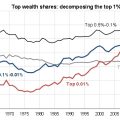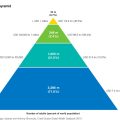World Wealth Distribution And Income Inequality In The World
The total wealth in the world at the beginning of 2013 was around $223 trillion. It has increased almost twice from $113 trillion in the year 2000. Here is an interesting infographic, showing some facts about world wealth. The most obvious thing you can see here is the inequality of its distribution among people. Did you know, that just 0.1% of all people own around 80% of all financial wealth? Around a quarter of the world’s wealth is located in the United States, which makes it the richest country in the world. Most of the millionaires on Earth are located there. Wealth inequality in America has been one of the lowest, too. Here are some more statistics:
Distribution of wealth in the world and income inequality
* 0.001% or around 91 000 of all 6 000 000 000 people own more than 30% of financial assets.
* 99.9% of all people own only 19% of financial wealth.
* Less than 20% of people get more than 80% of the world’s income.
* The poorest 20% or around 1 200 000 000 people receive only 1.4% of the world’s income.
* The financial crisis in 2007 vanished more than $30 trillion of the world’s wealth.
These and many more cool facts you can see here:
Income inequality has been growing for the last 30 years not only in the United States but also in most countries in the world. Although it has been dancing up and down, there has been a clear upwards trend for the last decades. It has become one of the major problems of today. Nobody knows what it will lead to, but I don’t think it will be anything good. In the following picture you can see how the wealth of the top 1% and top 0.1% has changed during the last years:

The share of all income in the US of the top 1% and the top 0.1% of the population. Source: https://en.wikipedia.org/wiki/Income_inequality_in_the_United_States
Wealth Inequality
Wealth inequality has been a persistent issue in the United States for decades, and in recent years, the gap between rich and poor has widened even further.
There are a number of factors that contribute to increasing wealth inequality, including income inequality, unfair pay disparities across gender and racial lines, and high levels of debt accumulated by individuals who can’t keep up with rising living costs. Income inequality arises when those at the top continue to acquire greater portions of money and resources than those in the lower income brackets, creating a growing gap between person-to-person wealth distribution. Unfair pay disparities are another major factor contributing to wealth inequality as women and minorities continue to suffer from unequal wages for equal work or even for accessing similar job opportunities as their white male counterparts.
Finally, high levels of debt create a vicious cycle for those on lower incomes as they struggle to make ends meet each month, trapping them in perpetual economic instability and thus making it difficult for them to accumulate meaningful wealth over time.
It is clear that tackling this issue presents many challenges but there is hope that with effective solutions we can reduce overall economic inequality in America and create opportunities for all individuals regardless of their background or income bracket.
If you like this post, please share it and support our site.



